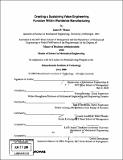| dc.contributor.advisor | Warren Seering and Sara L. Beckman. | en_US |
| dc.contributor.author | Thome, James P | en_US |
| dc.contributor.other | Leaders for Manufacturing Program. | en_US |
| dc.date.accessioned | 2009-01-30T16:31:05Z | |
| dc.date.available | 2009-01-30T16:31:05Z | |
| dc.date.copyright | 2008 | en_US |
| dc.date.issued | 2008 | en_US |
| dc.identifier.uri | http://hdl.handle.net/1721.1/44311 | |
| dc.description | Thesis (M.B.A.)--Massachusetts Institute of Technology, Sloan School of Management; and, (S.M.)--Massachusetts Institute of Technology, Dept. of Mechanical Engineering; in conjunction with the Leaders for Manufacturing Program at MIT, 2008. | en_US |
| dc.description | Includes bibliographical references (p. 59). | en_US |
| dc.description.abstract | Most product cost reduction in industry occurs during new product introduction (NPI). However, for some firms, a case can be made that product cost reduction efforts can be devoted towards products already in sustained production. These firms face a set of business conditions that often preclude exhaustive product cost reduction during NPI. These conditions include fast time to market requirements and the necessity of devoting engineering resources to a pipeline of innovative products needed to remain competitive in the market. These firms' products also possess characteristics that make cost reduction during sustained production viable. Products have sufficiently long lifecycles in which to realize project savings and a market that will continue paying prices that enable continued profitability. However, as expected, these firms often must devote resources to more pressing NPI needs, leaving sustained product cost reduction savings under-realized.Cisco Systems is a firm that faces these business conditions and has products that have these characteristics. Cisco Worldwide Manufacturing has thus devoted itself to improving Cisco's value engineering capabilities to a world class level. Value engineering at Cisco refers to product cost reduction activities that occur during sustained manufacturing. The research in this thesis set out to validate the hypothesis that Cisco could improve value engineering savings by funding cost reduction projects directly through Worldwide Manufacturing, rather than through the typical budget of a Cisco business unit. Cisco business units often have to prioritize NPI over value engineering. This thesis will discuss the process and results of a model that was established to provide value engineering project funding through Manufacturing. Results show that value engineering savings can be increased with this funding model. | en_US |
| dc.description.statementofresponsibility | by James P. Thome. | en_US |
| dc.format.extent | 59 p. | en_US |
| dc.language.iso | eng | en_US |
| dc.publisher | Massachusetts Institute of Technology | en_US |
| dc.rights | M.I.T. theses are protected by
copyright. They may be viewed from this source for any purpose, but
reproduction or distribution in any format is prohibited without written
permission. See provided URL for inquiries about permission. | en_US |
| dc.rights.uri | http://dspace.mit.edu/handle/1721.1/7582 | en_US |
| dc.subject | Sloan School of Management. | en_US |
| dc.subject | Mechanical Engineering. | en_US |
| dc.subject | Leaders for Manufacturing Program. | en_US |
| dc.title | Creating a sustaining value engineering function within worldwide manufacturing | en_US |
| dc.type | Thesis | en_US |
| dc.description.degree | S.M. | en_US |
| dc.description.degree | M.B.A. | en_US |
| dc.contributor.department | Leaders for Manufacturing Program at MIT | en_US |
| dc.contributor.department | Massachusetts Institute of Technology. Department of Mechanical Engineering | |
| dc.contributor.department | Sloan School of Management | |
| dc.identifier.oclc | 272405201 | en_US |
